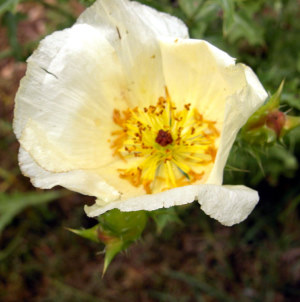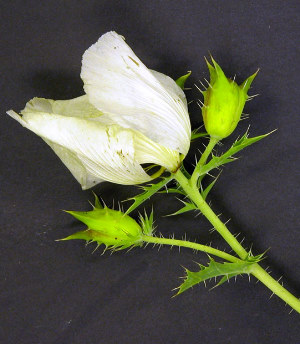Prickly Poppy
Argemone mexicana L., Argemone spp.
Papaveraceae (Poppy Family)
Prickly poppies are annual or biennial herbs that grow upright to about 3 to 5 feet tall. They are covered with prickles and have large, showy flowers with six white, yellow, or pinkish red petals. All of the prickly poppies contain yellow to orange latex sap (Correll and Johnston 1970). The latex sap and prickly poppy seeds are known to have poisonous properties, yet the plant was used for medicinal purposes by Native American healers.
At least three species of prickly poppy are common in the region, and a few others grow on the northern edge. These include Argemone mexicana (yellow prickly poppy), A. chisoensis (pink prickly poppy), A. albiflora, and A. polyanthemos (to the north). There are probably more species, but these are the most common. See Cheatham et al. (1995) for detailed discussion of the uses and distributions of Argemone species found in Texas.
Archeological occurrence. Prickly poppy seed has been noted in one site from the eastern Trans-Pecos, Tres Metates. It is likely to be recovered from archeological sites in the Lower Pecos when more studies are carried out of samples from rockshelters. Prickly poppy seeds measure about 3 mm across, and like most of the seeds in the flora of Texas, they would pass through ordinary archeological screens. Therefore they can only be recovered from unscreened samples or flotation samples.
Chemical composition. Prickly poppy contains a yellow/orange latex which is reputed to have both healing and damaging properties. The seeds contain isoquinoline alkaloids, including berberine and protopine; other sources list the alkaloids sanguinarine and dihydrosanguinarine. The substances cause dilation of blood vessels and resultant edema which can be sufficiently severe to cause death. Prickly poppy has been naturalized across the Indian subcontinent, and has drawn attention due to some high profile cases of mass poisoning. Mustard oil is widely used in India, and it has been adulterated with argemone oil, resulting in the poisoning of thousands of people (Sharma et al. 1999; Verma et al. 2001). Argemone oil also has been evaluated for use as a fungicide (Rai 1996). Based on the studies coming out of India, put prickly poppy on the list of plants you do not want to ingest for any reason.
Medicine. Native American use of the prickly poppy was limited primarily to external applications for burns and sores. The Shoshone crushed the seeds and applied them to boils, burns, or other open wounds. The Paiute made a salve from the crushed seeds and used the salve in a similar fashion. And the Kawaiisu applied the seed-salve to burns.
The salve was also applied to the scalp to rid the patient of head lice. The Shoshone would heat the root and apply it to a toothache. Prickly poppy was also used as a eye salve, and both the Shoshone and the Comanche extruded the yellow sap and applied it to the eyes (Carlson et al. 1940; Train et al. 1941). The roasted and crushed seeds were also used as an emetic by the Shoshone.
In Mexico, folk medicine applications of prickly poppy included both external and internal remedies. It is listed as a purgative, and as a treatment for chest pains and asthma, and as a curative for bad blood, fading liver, fevers, and bad breath. External applications include treatment of poisonous bites and sore eyes. It is quite a laundry list of uses, and one that I would approach carefully, given the propensity of argemone oil to cause edema and even congestive heart failure.
Other uses. The Tepehuan once gathered and crushed the leaves and stems of prickly poppy for use as a fish stupefying agent. Both the Tepehuan and the Tarahumara used several different plants for this purpose, and all of them have toxic properties (Pennington 1969). Two rather odd uses of prickly poppy include using it as a tattoo dye (Rogers 1980) and using the whole plant in children's initiation rites. The Hopi used it to whip unruly children, an application that most of us would not approve of in the 21st century. But having collected a fair amount of prickly poppy, I can attest to how effective it would have been in that application!
References:
Cheatham, Scooter, Marshall C. Johnson, and Lynn Marshall
1995 The Useful Wild Plants of Texas, the Southeastern and Southwestern United States, the Southern Plains, and Northern Mexico. Useful Wild Plants, Austin, Texas.
Correll, Donovan S. and Marshall C. Johnston
1970 Manual of the Vascular Plants of Texas. Contributions from the Texas Research Foundation, Volume 6. Renner, Texas.
Martinez, Maximino
1969 Las Plantas Medicinales de Mexico. Quinta Edicion. Ediciones Botas. Mexico, D.F.
Pennington, Campbell W.
1963 The Tarahumara of Mexico: Their Environment and Material Culture. University of Utah Press. Salt Lake City, Utah.
1969 The Tepehuan of Chihuahua: Their Material Culture. University of Utah Press. Salt Lake City, Utah.
Rai, M.K.
1996 In Vitro Evaluation of Medicinal Plant Extracts Against Pestalotiopsis mangiferae. Hindustan Antibiotic Bulletin 38 (1-4): 53-56.
Sharma, B. D., S. Malhotra, V. Bhatia, and M. Rathee
1999 Epidemic Dropsy in India. Postgraduate Medical Journal 75(889): 657-661.
Verma, S. K., G. Dev, A. K. Tyagi, S. Goomber, and G.V. Jain
2001 Argemone mexicana poisoning; Autopsy Findings of Two Cases. Forensic Science International 115(1-2): 135-141.
![]()

